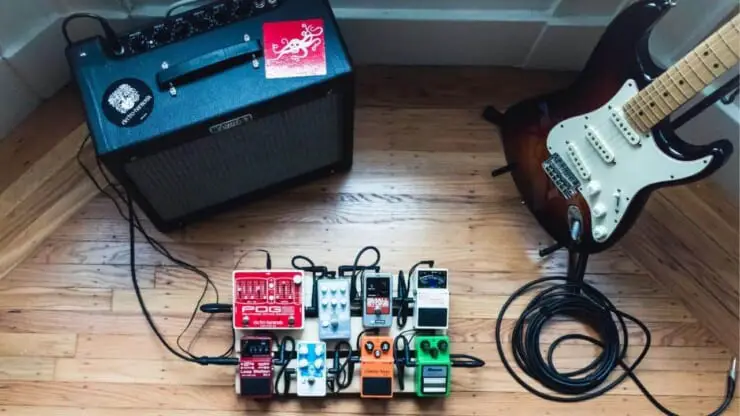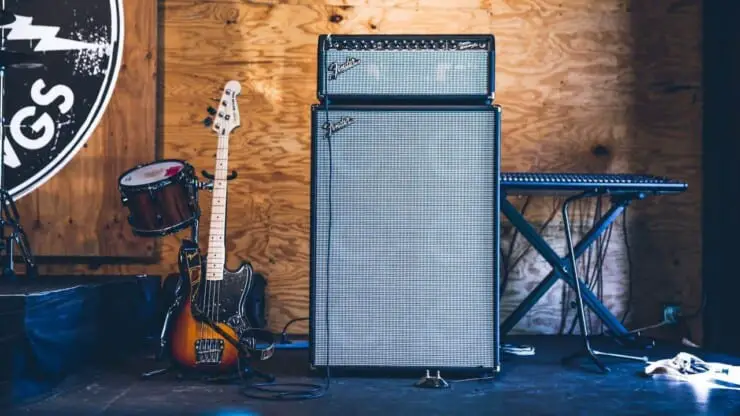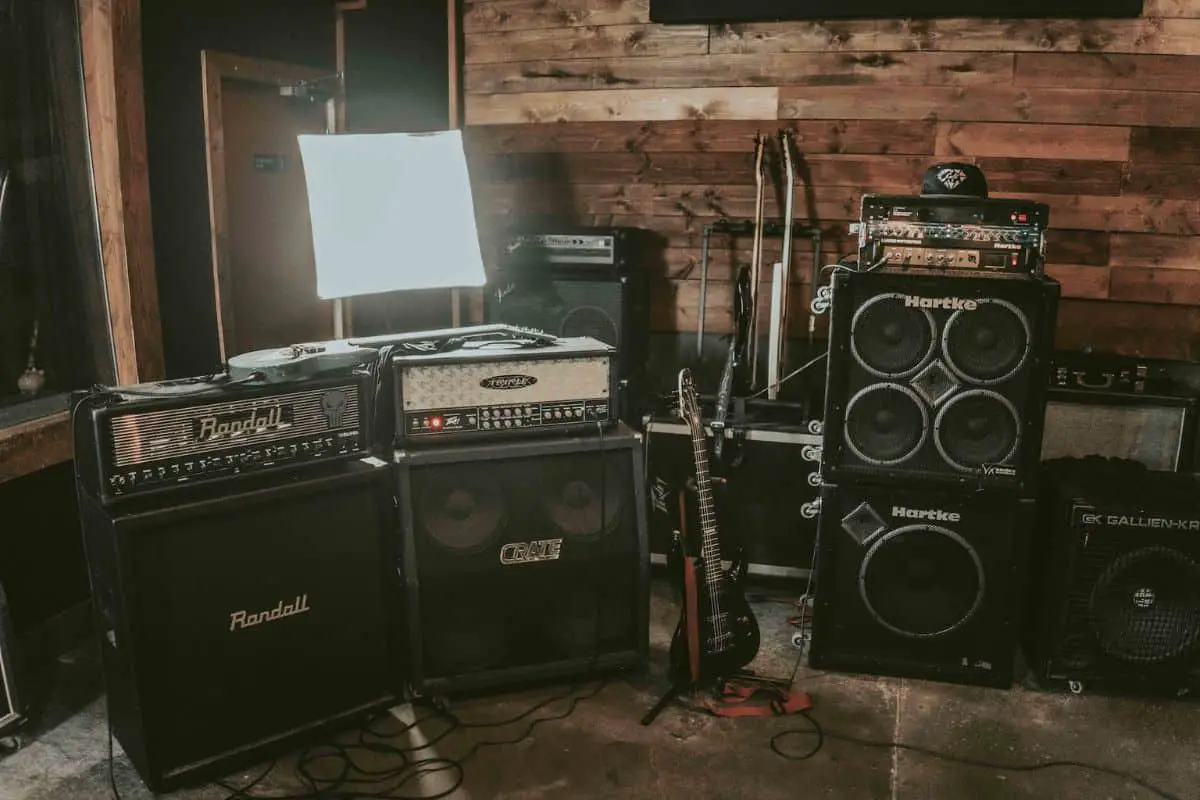Have you been wondering if you could connect multiple guitar amps together and get a more powerful sound? Luckily for you, it is possible, and this process is called daisy-chaining guitar amps.
Daisy-chaining guitar amps is the simplest way of connecting two guitar amps together. All you need to do is connect the guitar to the input of one amp and output the signal to the input of another amp. This will allow you to maximize the tone and dynamics.
In this article, you’ll get to know all about daisy-chaining amps, what do you mean by daisy-chaining amps, how to daisy chain guitar amps, what are the alternatives to daisy-chaining amps, are there any negatives to daisy-chaining, and more. Continue reading to get all the answers that you’re looking for.
Can you daisy chain multiple guitar amps together?
Sometimes, you would want your guitar to sound even louder. In fact, which guitarist doesn’t think about rocking out their guitar with a wall of amps behind them. Although it might seem like this is something only the biggest rock bands have access to, there are ways you can get more power from your amps. This is possible by connecting multiple amps together and as they say, two is bigger than one. There are many ways to do that, and one of the best and simplest one is called daisy-chaining. It will allow you to connect multiple amps together and play the sound from one guitar.
It is possible to daisy chain guitar amps, but the potential to do so will depend on the amps that you intend to daisy-chain. The important thing here is to know the correct way of connecting your amps to avoid damage while also getting the sound you want.
Daisy-chaining guitar amps is arguably the easiest way to connect multiple guitar amps together. This is done by connecting the guitar to the input of one amp and outputting the signal to the input of another amp. However, there are certain issues that should be considered to avoid noise issues. Daisy-chaining guitar amps is essentially the process of sending the output of the guitar to multiple amps. This will increase the total volume while impacting the overall tone of the guitar rig. There are many ways you can achieve it, some of which are straightforward and others that’ll need more consideration.
How to daisy chain guitar amps together?
Daisy-chaining is the simplest method to connect two guitar amps, and it requires the least equipment. All that you’ll require is a guitar, two standard instrument jack cables, and two amplifiers. Although this method is easy, there are some trade-offs that you’ll be reading about later on.
Firstly, you’ll need to check the number of inputs and outputs that are included in your guitar amps. One of the amps must be having two or more inputs. Otherwise, you’ll have to use one of the alternative methods. If both of your guitar amps are having multiple inputs, it won’t matter which order you’re setting them up in. Meanwhile, if only one of the amps has two or more inputs and the other one has just one, you’ll be plugging your guitar into the amp having multiple inputs. It must also be positioned first in the chain.
Once the two amps have been positioned, you’ll have to grab two instrument jack cables. One of the cables has to be plugged into the guitar’s output while having the other end plugged into the first input of the first amp. After that, plug the second cable into the second input of the first amp. The other end of the cable needs to be plugged into the first input of the second amp. Then, you should form the daisy chain.
You may be wondering how the input from the first amp can act as the output and send the guitar signal to the input on the second amp. This happens as the vast majority of inputs on a dual-input amp will be parallel and connected. These things are what make this simple method so easy.
A common issue here is that the outputs from the two amps could be out of phase with each other. It means that the waveforms end up canceling out each other, which leads to certain frequencies being subdued. Phasing issues will be easy to hear. If you’re able to tell that the outputs aren’t sounding as full-bodied and substantial as they normally do, you should just take the speaker cables from one of the amps and reverse them. This will immediately put the amps in phase with each other and then rectify the issue.
Different ways to daisy chain guitar amps together
1. Daisy-chaining amps using foot pedals
For daisy-chaining amps using foot pedals, you’ll require a foot pedal that has multiple outputs (usually a right and left output). You’ll also require three instrument cables and your guitar. You should start off by plugging your guitar into the foot pedal using one of the instrument cables.
After that, you should take the other two instrumental cables and plug one of them into each output of the pedal. The instrument cables will then be plugged into the two amps you are looking to daisy chain. Guitar signals then travel through the foot pedal and out to both of the amps.

The reason this is so remarkable for stereo effects pedals is that each output will relate to a different side of the stereo signal. For instance, if you’re using a stereo delay, these pedals create a ping-pong effect jumping from left to right repeatedly. When plugging into a single amp, this effect will be pretty hard to notice. When connected to multiple amps, this ping-pong effect jumps between the amps and creates a more dynamic sound.
2. Daisy-chaining amps using AB/Y Splitter
Using an AB/Y splitter for daisy-chaining your amps will be an extremely reliable and straightforward option available. For this method, you’ll require two amps, a guitar, three instrument cables, and an AB/Y splitter.
An AB/Y splitter is essentially a small box that looks similar to an effects pedal, but doesn’t add any effects to the guitar. Instead, you’re plugging the guitar into it and duplicating the guitar playing across multiple outputs.
For daisy-chaining your amps with an AB/Y splitter, you’ll first be plugging your guitar into an AB/Y splitter’s input. Every AB/Y splitter is different, but usually, on the back of the pedal, you’ll get between two and four outputs. After that, take the other instrument cables and plug them into the outputs. Lastly, plug the other ends of the cables will go into the amps.
Using an AB/Y splitter will add versatility to your daisy-chaining by allowing you to easily switch amps. You can either duplicate the guitar’s sound across both amplifiers, or press it to switch between sending the guitar’s sound to only one of the amps. This helps if you’re jamming, and you’ve to see which of the amps best suit the songs that you’re playing.
3. Daisy-chaining amps directly to each other
Daisy-chaining one amp directly to the other amp is the easiest method for connecting two amps together. To pull off this method, you’ll need two amps that you want to daisy chain, two instrument cables, and your guitar.
If you’re having a guitar amp with the secondary output at the back or an effects loop, it should be the amp that you’re plugging your guitar into. If both amps have them, then the order probably doesn’t matter. You can just plug the guitar into the first amp as you would do normally.
After that, take your second instrument cable and then plug it into either the effects loop output or the secondary output of the amp. Take the other end of the second cable and then plug it into the input of the second amp.
Why should you be daisy-chaining your guitar amps?
Sometimes, using a single amp doesn’t offer enough power and volume needed for a performance. Many guitarists and musicians, therefore, incorporate multiple guitar amps into their rig to get better tone and dynamics. Daisy-chaining will be the method to connect two or more amps together for amplifying the sound of the guitar. This idea comes from the need to get more volume.
- By daisy-chaining amps together, you can potentially double your volume or achieve a stereo loud field when performing live.
- Another reason for daisy-chaining will be to chain two less powerful amps together. This will allow you to match the volume of your bandmates if they are having louder amps.
- Aside from sheer volume, different amps will have different sound characteristics. Daisy-chaining two amps together can give you the sound that wasn’t possible from either amp alone.
Are daisy-chaining and amp stacking the exact same thing?
No, although many beginners misinterpret them as the same thing, but daisy-chaining and amp stacking are two different things. Amp stacking is the combination of the amp head connected to one or more guitar cabinets. Amp heads will amplify the guitar input, but you won’t be having a speaker. Instead, you’re connecting them to a cabinet, which will act as a speaker.
The reason that amp stacking and daisy-chaining are different is that amp heads are designed for connecting to multiple cabinets. Moreover, the cabinets are equally amplified by the same amp head.

Cabinets are very similar to guitar amps. However, instead of amplifying the guitar, they’ll take the signal from the amp head and then make it louder. The primary reason why it’s different from daisy-chaining is that when you’re connecting two amps together, both the amps will individually amplify the signal. Amp heads are designed to get hooked up to multiple cabinets and usually have 2-3 outputs for achieving just that.
Alternatives to daisy-chaining
There are definitely better ways of connecting two guitar amps together aside from daisy-chaining. These methods include using effects pedals and buffer splitters. Using these methods means that you’ll be able to avoid the pitfalls and issues of daisy-chaining, like overdriving the second amp by splitting the sound of the guitar instead of duplicating the amp’s sound. Here are some of the alternatives if you don’t want to daisy chain your guitar amps –
Use effects pedals to connect guitar amps
If neither of your amps has two or more inputs, there’s another way you can connect two guitar amps together. This is the method that you can use as an alternative to daisy-chaining. It’ll involve using effects pedals that have stereo inputs. Many popular stompboxes come with two outputs installed to split signals.
Say that you’re having a pedal like the Electro-Harmonix Micro Pog, which is essentially an octave shifter. This pedal will feature two outputs, labeled “Dry Out” and “Effect Out”. This is designed for facilitating signal splitting, allowing you to easily separate outputs from the pedal and into your two amps. This technique is used by many bassists and guitarists. It’ll allow them to separate the dry and wet signals such that they can be sent to multiple amps. However, you can also use a dual-output pedal for linking two amps and playing identical signals from both of them.
Using the Electro-Harmonix Micro Pog as an example, you’ll have to plug your guitar into the input of the pedal via a standard instrument jack cable. After that, a second jack cable will have to be plugged into the “Effect Out”. Meanwhile, the other end will be plugged into the input of the first amp. Another jack cable will be plugged into the “Dry Out” and sent into the input of the second amp. It’ll successfully link your two amps, with the effects pedal acting as the middle ground between them.
You should remember that with this method, the signals can only be identified once the effects pedal is turned off. Once the effect has been engaged via the footswitch, the signal from the “Effect Out” gets subjected to the pitch-shifted effect. This will play out through the second amp.
If you’re using multiple effects pedal in your signal chain, isolate certain effects and send them to the second amp. This will be a great way of thickening up the tone. This means when you’re engaging the effects, the clean sound of the guitar is still present in the dry amp. Bass guitarists generally use this technique if they’re playing in a 2 or 3-piece band. It’ll create the illusion of a second or third guitar double-tracking the notes they’re playing. Moreover, it’ll allow them to be much more precise when sculpting the processed tone.
Use buffered splitters to connect guitar amps
Another great alternative to daisy-chaining would be by linking two guitar amps by using a buffered AB/Y splitter. However, before you rush off to look for any AB/Y splitter, ensure that you’re using one that is buffered. Generally, AB/Y splitters are a hit-and-miss when it comes to performance and signal clarity they offer. You can always go for cheap options, which will do more than a decent job. If you want maximum reliability, a dedicated AB/Y switching box like an Orange Amp Detonator will be your best option.
It’ll be important to make the distinction between active and passive splitters. Passive AB/Y splitters will weaken the guitar’s signal as it’ll be transmitted to your multiple amps, halving the strength. Therefore, if you want to maintain the natural tone and signal strength of your amp and guitar, passive AB/Y splitters will likely disappoint you. Active splitters will improve the issue, but they also color the tone of the guitar, especially the cheaper ones.
This is where the buffered AB/Y switches are beneficial. Using a buffered splitter will ensure that the signal strength gets maintained. Moreover, it’ll also improve the performance of all the other pedals in your signal chain. Buffered AB/Y devices usually have useful features like ground loops, phase switching, and impedance matching. This will allow you to easily tailor the pedal’s settings to make sure they’re optimally suited to the two or more amps you’re looking to connect together.
The more affordable option will be to go for a passive AB/Y splitter. If you’re running into noise problems like an increase in the electrical humming or any issues with ground loops, combine the splitter with a D.I. (direct input) box. These devices are used commonly and quite regularly in live performance settings. All you’ll have to do is plug the guitar into the input of the DI box. After that, hook your first amp to the output of the DI box. Then, connect the other output to the second amp.
While this method is very reliable, there isn’t any guarantee that both of the amps will sound exactly like they do when they’re used on their own. This is the case because the DI box might cause coloration. Moreover, the input impedance of both of the amps combined is different from when they are used individually.
What are the pros and cons of daisy-chaining multiple amps?
The biggest plus point of daisy-chaining is that you’ll get much more volume and hear the guitar in stereo. Having extra volume will be helpful for performing live. This way, your guitar will be able to compete with the volume of the rest of the band. The ability to be able to play your guitar in stereo will be another huge draw towards daisy-chaining amps. This will come in especially handy if you are using stereo guitar pedals like stereo delays. It means that the stereo effects actually play in stereo, which creates interesting sonic sounds that aren’t possible with a single amp.
The downside to daisy-chaining amps will be that the amps could sometimes behave unpredictably when connected. It can present you with issues related to volume, tone, and phasing.
Phasing is a fairly common issue that happens when daisy-chaining multiple guitar amps together. Phasing will refer to how the sound waves of different amps interact with each other. If the two amps are out of phase, it will mean that their waveforms are canceling out each other.
It can often result in the sound coming out of the chained amps sounding a bit incomplete. Sometimes, you can even lose the low-end and generally, the sound wouldn’t be as well-rounded as you are used to. Phasing issues can be resolved easily. If you unplugged the guitar cables from an amp’s output and reverse the way you have plugged in it, this puts the two backs in phase.
Can daisy-chaining destroy the guitar amps?
Chasing more volume will come with its own risks and pitfalls. The riskiest way of daisy-chaining amps will also be the easiest way of doing so. If you run your guitar into an amp having speaker outs and run those speaker outs into another amp, you’re running the risk of delivering a lot of power to the second amp. This could end up overdriving the amp to the point where you may start seeing smoke. You should avoid it at all costs.
Conclusion
Thank you for reading. Hopefully, now you know all about daisy-chaining amps, what do you mean by daisy-chaining amps, how to daisy chain guitar amps, what are the alternatives to daisy-chaining amps, are there any negatives to daisy-chaining, and more. If you’re looking to connect two guitar amps together, daisy-chaining them will be the simplest way to do so. All you need to do is connect the guitar to the input of one amp and output the signal to the input of another amp. This will allow you to maximize the tone and dynamics.



